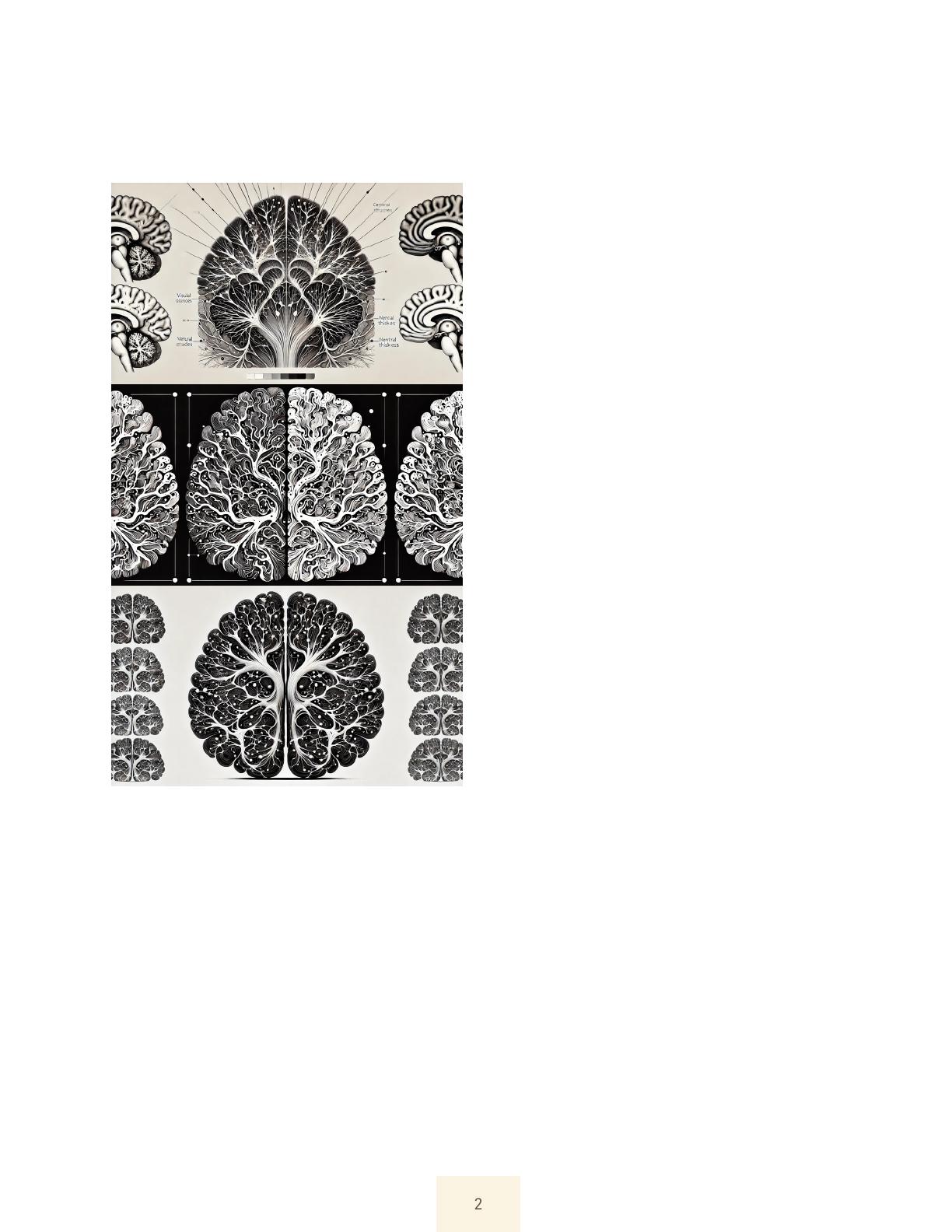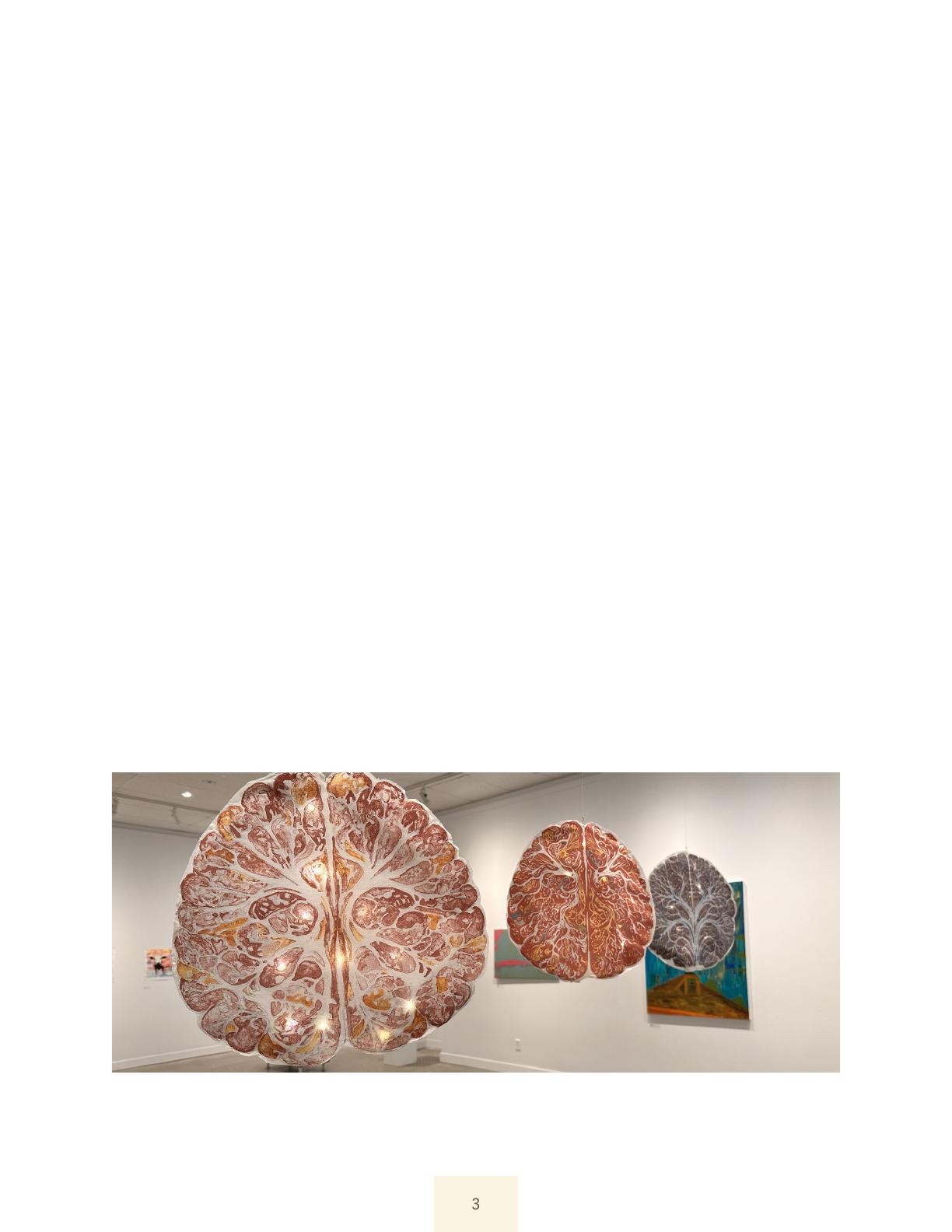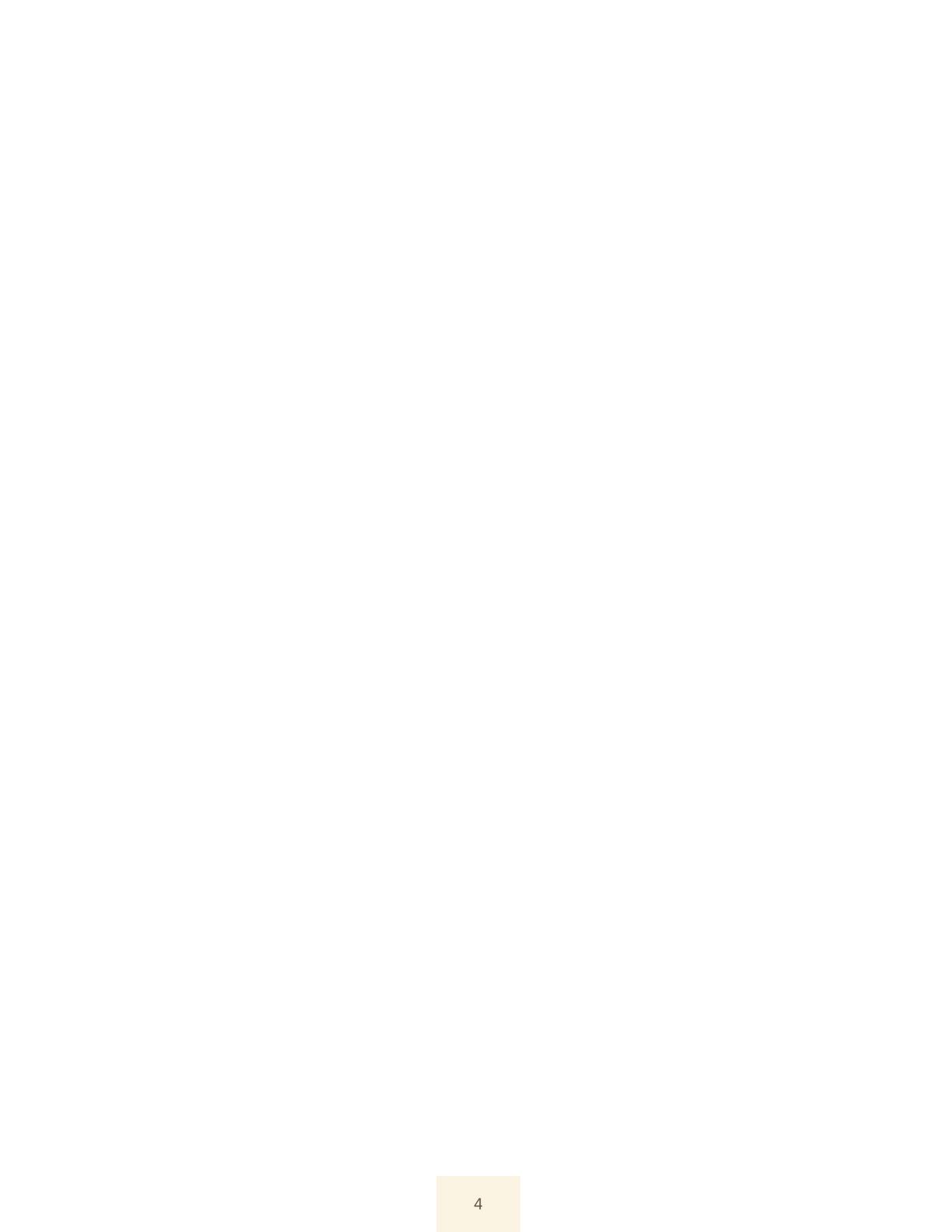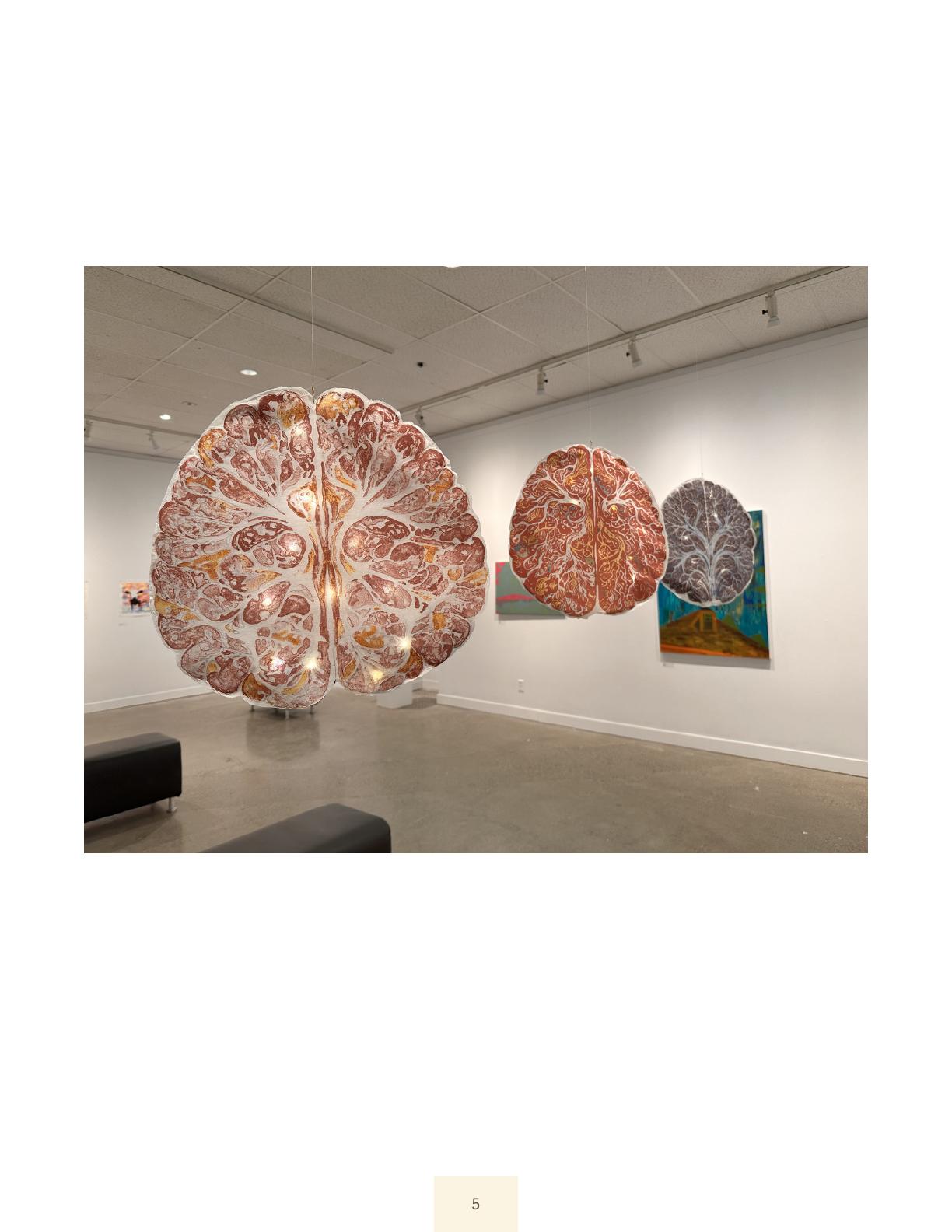
1
ISSN: XXXX-XXXX SPECIAL ISSUE 2025
This work is licensed under an Aribution-NonCommercial-NoDerivatives 4.0 International license.
Janet McChesney is one of the participating
artists whose work exemplifies this exploration.
AI Tool: DALL-E
ARTIST STATEMENT
This so sculpture of the brain, with its intri-
cate neural pathways, emerged from a desire to cra
a large-scale piece independently, free from the con-
straints of heavy machinery or a woodshop.
I love abstract sculpture, and the brain’s
complexity provides an incredible subject for
interpretation in so, textured materials that are
This special issue of Future Earth Journal:
Explorations in Art and Generative AI showcases
the work of visual art students from the Fall 2024
Selected Topics visual art course Explorations in Art
and AI. Each featured artist engaged with genera-
tive artificial intelligence (Gen AI) to create original
artworks that respond to and reflect on current
conversations in art and technology. Through their
unique practices, these students explored Gen AI as
a tool, a collaborator, and/or a conceptual influence.
The artworks featured here—and in the exhibi-
tion held at the TRU Art Gallery from March 17–29,
2025—highlight the cultural, ethical, environmental,
and creative dimensions of using Gen AI in artistic
production.
YOU SEE
Janet McChesney
Bachelor of Fine Arts, Thompson Rivers University, 2021
Figure 1. You See (2024), by Janet McChesney [close up images of each sculpture].
So sculpture, screen printed fabric with mylar and lights, 17" x 19" (each). (Image credit: Nicole Favron)

2
accessible and adaptable. The neural pathways and
synapses that allow us to see are generally taken
for granted. As visual artists we endeavour to make
our vision come alive in our work so that others
can see what they see, Viewers vision, choices and
stories may be dierent but we are all impacted by
seeing. Reflecting on this amazing ability is the story
I wanted to share.
Artistic Process
The brain itself is a so, intricate structure, so I
used fabric and screen printing to echo this natural
soness.
I printed three cross-sections of the
visual neural pathways, top, middle
and bottom, using AI-generated
images for anatomical accuracy. I lay-
ered these via screen printing onto a
variety of fabrics giving me the options
for embellishing the works.
The choice of so materials allowed me to
mirror the brain’s structure in an approachable form
while connecting the viewer to the fundamental
sensory experience of seeing. Creating this piece
brought many challenges, from shaping the neural
links to making them comprehensible and visually
engaging. I tried out a variety of materials each with
dierent issues from to so, too slippery, too opaque,
too delicate etc. before seling on an approach. I
integrated embroidery, acrylic and metallic paint,
and baery-operated lights to illuminate pathways
hoping to intrigue viewers with the intricacies of the
brain’s networks. I considered shaping them and
arranging them horizontally and vertically.
Like most of my experiments and experiences
with creating abstract art, you learn while doing and
end with ideas for how you might redo it dierently
next time.
Concept and Meaning
Emphasizing the role of sight—a critical ele-
ment in both art and human experience, these
neural pathways guide viewers to look closely and
consider the structure of their own brains and the
marvelous complexity that give us the ability to
see. At one level seeing is an organic process, one
oen taken for granted, but it is also the start of
making meaning. Humans have been called ‘mean-
ing making machines” and a lot of making meaning
begins with seeing.
Personal Reflection
AI has been a tool, a guide and an idea genera-
tor as well as a camera to show me pictorial images
of my ideas. It is not always accurate, but it is always
interesting. I see it as a vast library of information
that has been valuable in project planning, generat-
ing ideas and problem solving for stumbling blocks
Figure 2. DALL-E generated images of the top, middle and
boom slices of the brain.

3
like ideas to improve things it’s prey good. Just
don’t expect it to reproduce what you are thinking
about in your mind, it isn’t you, but it’s an idea aid.
Audience Engagement
This work issues an invitation to step closer,
explore from multiple angles, and experience a
blend of scientific accuracy and artistic inter-
pretation. The hanging structure allows viewers
to move around it, creating a sense of wonder
at the hidden intricacies of our bodies and the
extraordinary complexity of perception. I had
to give up on it being see through but depend-
ing on how it is hung you can move through it
as well and see it from both sides. It is sturdy
enough to be touched.
Context and Inspiration
Part of my broader artistic practice, which
oen depicts forms found in nature, this sculpture
is a continuation of my fascination with the world
and our connections to it. A theme running through
my work is using nature as a jumping o spot to
draw aention to something and tell a story. From
Humpback whale flukes and swarming Killer Bees,
Zebra Mussels and large abstract metal forms that
began with the inspiration of a protractor and geom-
etry set, something in the ‘here and now’ catches my
along the way.
Aer multiple aempts to generate good
images of geographical convolutions and inter-
sections, when I wanted to display the hills and
mountains and geography around Kamloops I gave
up. I found no good depictions of the layered land-
scapes that are so prominent here and the various
ways to make a scaled sculpture relied more on
the expertise of geographers than any compelling
picture AI could give me. I wanted to create the land-
scapes using AI and it was a no go. So I turned my
aention to other things in nature that are convo-
luted. That’s where the brain came in. That was an
idea I chose to pursue.
Then I needed assistance in focusing on which
part of the brain I wanted to depict in my work
and how to get anatomically accurate pictures of
the neural pathways for vision. When I was trying
to figure out how to make the ‘slices’ of the Brain-
top, middle and boom- AI provided anatomically
correct pictures that I needed to enlarge, print and
transfer to screen printing screens. When I wanted
the visual areas to stand out, I used AI to get ideas.
Embroidery and lighting were oered along with
other ideas. At lightening speed, AI gave me a mini
manual of ideas from which I could pick. I see it as
a repository of information and ideas, a super fast
search engine, an advisor. It advises, I make the deci-
sions. And for some things like project planning and
management it is a good advisor. For other things
Figure 3. You See (exhibit installation, 2024), by Janet McChesney.
So sculpture, screen printed fabric with mylar and lights,
17" x 19" (x 3). (Photo credit: Twyla Exner)

4
interest and o I go.
For this work, I began thinking about the geog-
raphy of the hills around Kamloops with their peaks
and curves and interconnection, the unique layers of
sediment, rock, clay that forms the landscape. This
idea was a non starter for using AI, totally frustrating
but it did lead to the curves and interconnection in
the brain and how to tell that story.
Through the brain’s complex pathways, I hope
to oer viewers not only a visual experience but also
a moment of reflection on the awe-inspiring and
nearly unfathomable processes that govern what
we see, how we see and how that influences our
thoughts and perceptions.
Process
Janet used DALL-E to generate images of the
human brain to create maps of the neural pathways
to the visual cortex. She wanted to show the areas of
the brain that light up when we see images. DALL-E
generated multiple maps of the brain, visually rep-
resenting it in slices and indicating areas where it
would light up in response to visual stimulation.
Janet used the generated images to create screen
prints, which are printed on fabric. The fabric con-
tains a mylar template which holds LED’s in place
and represents the lighting up of visual cortex in the
brain.

5
Exhibit Installation of You See by Janet McChesney (Image credit: Twyla Exner)
